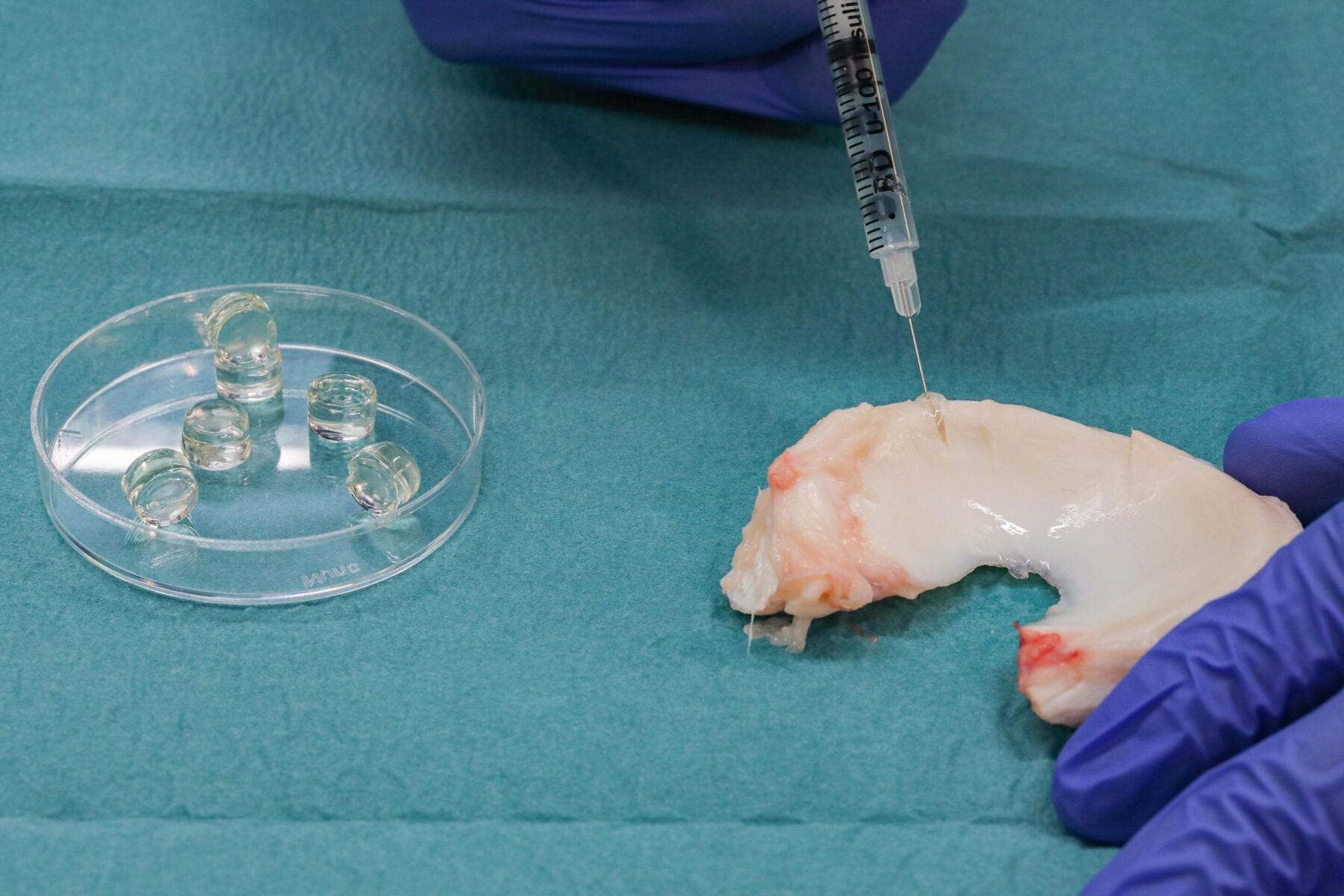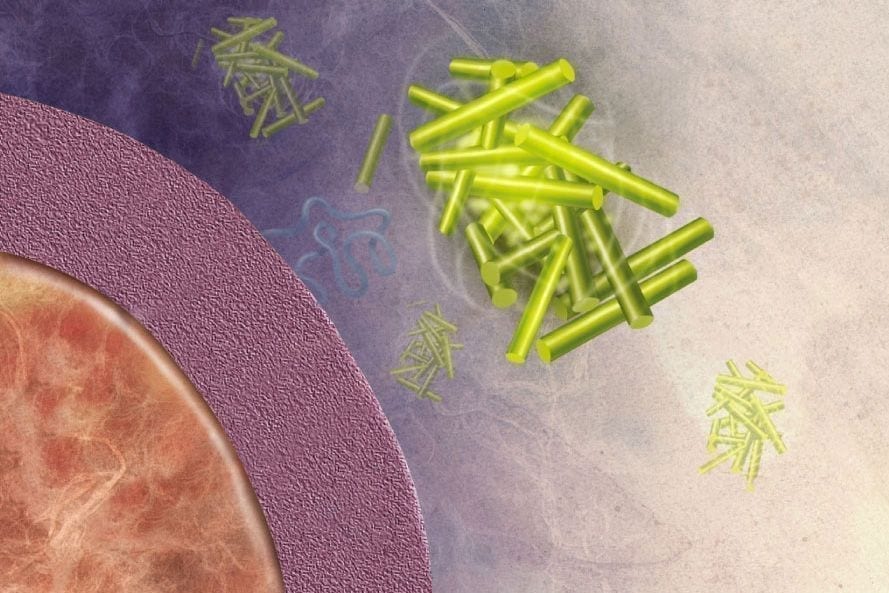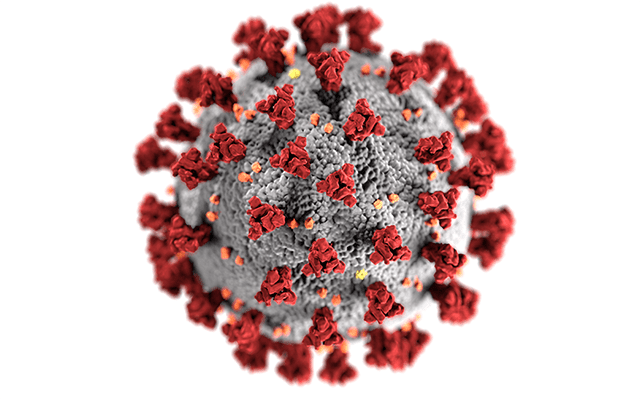
The gel is injected directly into the tissue.
Credit: Alain Herzog 2021 EPFL
EPFL scientists have developed an injectable gel that can attach to various kinds of soft internal tissues and repair tears resulting from an accident or trauma.
Our soft tissues can be torn during a ski accident, a car accident or an accident in the home, for example. And surgeons can have a hard time binding the tissue back together, as stitches often do more harm than good. According to Dominique Pioletti, the head of the Laboratory of Biomechanical Orthopedics at EPFL’s School of Engineering, such surgeries don’t always produce optimal outcomes because the repaired tissue usually doesn’t heal properly. This tends to be the case for tears in cartilage and the cornea, for instance.
Researchers around the world have been trying for years to develop an adhesive for soft tissue that can withstand the natural stresses and strains within the human body. Pioletti’s group has now come up with a novel family of injectable biomaterials that can bind to various forms of soft tissue. Their bioadhesives, in the form of a gel, can be used in a variety of injury-treatment applications. Their research has just been published in Macromolecular Rapid Communications.
Sticks like glue
The hydrogel produced at LBO is made up of 85% water and has two key advantages: it can be injected anywhere in the human body, and it demonstrates high intrinsic adhesion with no extra surface treatment. “What makes our hydrogel different is that it changes consistency while providing high adhesion to soft tissues,” says Peyman Karami, a postdoc at Pioletti’s lab who has developed the gel during his PhD. “It’s injected in a liquid form, but then sets when a light source is applied, enabling it to adhere to surrounding tissue.”
The scientists’ hydrogel works through an entirely new design that allows for independent control of its mechanical and adhesive properties. The result is a versatile hydrogel that doctors can use as a glue for soft tissue throughout the human body.
Inspired by mussels
To obtain these versatile properties in their hydrogel, the scientists took the base polymer and modified it with the compounds that play an important role in tissue adhesion. The first is known as Dopa and is derived from mussels. “Dopa is what lets mussels attach firmly to any kind of surface – organic or otherwise,” says Pioletti. The second is an amino acid that our bodies make naturally.
Original Article: New hydrogel can repair tears in human tissue
More from: Ecole Polytechnique Federale de Lausanne
The Latest Updates from Bing News & Google News
Go deeper with Bing News on:
Bioadhesives
- Ocular Surface Reconstruction: Recent Innovations, Surgical Candidate Selection and Postoperative Management
Figure 2 provides a birds-eye view of the current and future trends in the management of severe OSD. Current management may not completely restore the functions and structure of the ocular surface ...
- Vietnam Bioadhesives Market 2024 Major Players, Competitive Spectrum, Revenue Share and Sales Projections by 2032
The recent analysis by Report Ocean on the “Vietnam Bioadhesives Market” Report 2024 to 2032 revolves around various aspects of the market, including characteristics, size and growth, segmentation, ...
- Global Bioadhesives Market Size, Share And Forecast To 2031
(MENAFN- Straits Research) Bioadhesives include naturally occurring polymeric substances with adhesive properties and modified synthetic substances. This category contains glues derived from ...
- Wounds and Healing News
Apr. 2, 2024 — Polymer-based hydrogels are used to treat skin ailments and in tissue engineering because of their ability to retain water, deliver drugs into wounds, and biodegrade. However ...
- Yuyu Sun
Polymers and Biopolymers in Biomedicine; Antimicrobial and Biofilm-Controlling Systems, Drug Delivery and Biomedical Devices. Functional polymers; Antimicrobial and Biofilm-Controlling Polymeric ...
Go deeper with Google Headlines on:
Bioadhesives
[google_news title=”” keyword=”bioadhesives” num_posts=”5″ blurb_length=”0″ show_thumb=”left”]
Go deeper with Bing News on:
Hydrogels
- No Antibiotics Needed – Revolutionary Chronic Wound Treatment Could Help Millions
An international team of scientists has developed a new treatment for chronic wounds that uses ionized gas to activate a wound dressing, without the need for antibiotics. The treatment involves the pl ...
- 3D Cell Culture Industry Is On Track To Achieve A US$ 5.14 Billion Valuation By 2031, Growing At A 14.59% CAGR
Scaffold-based technologies, which utilize hydrogels, extracellular matrices (ECMs), and other structures to mimic natural cell environments, hold the largest market share at around 60%. This ...
- May 2024 edition: Intuitive’s DV5, pediatric device design and diabetes tech
The May 2024 issue of MDO features Intuitive's da Vinci 5 surgical robotics system, pediatric device design tips and diabetes tech updates.
- HKU Mechanical Engineering researchers develop miniaturised electric generators based on hydrogels for use in biomedical devices
The development of engineered devices capable of harvesting the body’s mechanical motion and converting it into electricity is crucial for the functioning of bioelectronics.Mechanoelectrical energy co ...
- The UW’s Institute for Protein Design keeps boosting startups, fueling AI-powered science
University of Washington Institute for Protein Design head David Baker (left) and assistant professor Neil King show off molecular models of proteins. (UW ...
Go deeper with Google Headlines on:
Hydrogels
[google_news title=”” keyword=”hydrogels” num_posts=”5″ blurb_length=”0″ show_thumb=”left”]










